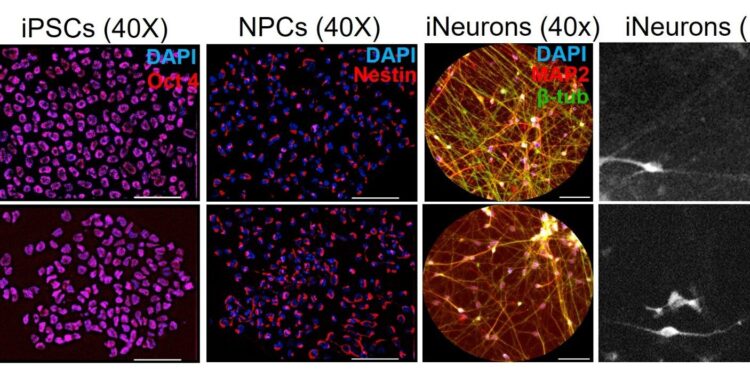A comparison of healthy human neurons with the neurons of a patient from Huntington’s disease where GSK3ß and Erk1 have been regulated upwards. Credit: Krzystk and Gunawardena / University in Buffalo
Ten years ago, researchers at the University of Buffalo shed light on a mystery of lasting neuroscience: how does a mutated Huntingtine protein (HTT) cause Huntington’s disease exactly?
They found that HTT is something like a traffic controller inside neurons, moving different cargoes along the neuronal highways called concert axons with other proteins that are essential for cellular function and survival. Reduce the quantity of non -mutant HTT and you create the neurological equivalent of traffic jams and roadblocks.
Now the researchers have learned more about what can control the traffic control HTT.
They found that two specific signaling proteins, GSK3β and ERK1, were expressed more in patients with patients with Huntington’s disease, they therefore prevented them from operating in the neurons of fruit flies that have mutant htt. This inhibition of GSK-3β actually led to less defects in the axonal transport process and less neural cell death, while ERK1 inhibition has led to more transport problems and more cell death.
“With these results, we propose that ERK1 can protect neurons in the face of Huntington’s disease, while GSK3β can exacerbate Huntington’s disease,” said Shermali Gunawardena, PH.D., Associate Professor of Organic Sciences at the College of Arts and Sciences of UB. “Therapies can one day be able to target these signaling proteins in different ways – inhibiting GSK3β and increasing ERK1 – to treat this severe and deadly neurological disorder.”
Gunawardena is the corresponding author of a study detailing research, which was published in Death and cell disease.
Two proteins, two opposite effects
When the HTT Mute gene, it repeats too many times the cytosine-adenine-guanine (CAG). Why does this decrease the physical and mental capacities of a person – from the mature age – is not clear, because the normal HTT goal and function are not entirely understood.
In what was a piece of this puzzle, the Gunawardena team previously noted that HTT moves along the axonal motorways by reaching a walk on cargo cargo cargo cargers called vesicles. These vesicles are themselves moved by motor proteins called dyneines and kinesins.
“This time, we focused on the signalers that really regulate all this complex transport system: a group of proteins called Kinases,” said the first author of the study, Thomas J. Krzystek, who received a doctorate. In the biological sciences of the UB in 2022 and is now the main scientist at Abbvie. “Kinases modify HTT and other transport components by attaching molecular labels to them called phosphate groups.”
The Kinases GSK3β and Erk1 attracted the team’s eye because they were regulated upwards in neurons with Huntington’s disease compared to normal neurons.
To better understand this in a living organism, they turned to fruit fly. The inhibition of the GSK3β in fruit flies with Huntington’s disease has reduced their axonal blockages and their neural cell death. Fruit flies have even crawl better.
In a previous study, they found that GSK3β – shortcut for glycogen Synthase Kinase -3beta – contributes to motor proteins to stop or go, and that too GSK -3β or too little can disturb motors and cause traffic blocks by different mechanisms.
“Thus, although GSK3β generally plays a positive role in the neural function, it seems that it can actually worsen a bad situation in the face of a mutant HTT,” explains Gunawardena.
Conversely, inhibiting Erk1 – which for the extracellular kinase linked to the signal – increased axonal blockages and cell death.
“The level of ERK1 is clearly important for Huntington’s disease, but that it does not modulate the mutant HTT is not clear,” explains Krzystek. “In any case, the signaling of this ERK1 path is neuroprotective in the context of Huntington’s disease.”
The team also tried to raise the levels of ERK1 and found it decreased traffic blockages and cell death.
“As long as this does not affect the other processes in which ERK1 could be involved, future treatment could potentially increase the ERK1 levels of a patient to mitigate the death of neural cells,” said Gunawardena. “There is not much to do once the dead cells, so our entire research try to understand these key and early processes which lead to cell death and if it can be avoided.”
More information:
Thomas J. Krzystk et al, opposite roles for the phosphorylation of GSK3β and Erk1 dependent on Huntingtine during neuronal dysfunction and cell death in Huntington’s disease, Death and cell disease (2025). DOI: 10.1038 / S41419-025-07524-0
Supplied by the university in Buffalo
Quote: A protein attenuates Huntington’s disease, and one enlarged (2025, May 5) recovered on May 5, 2025 from
This document is subject to copyright. In addition to any fair program for private or research purposes, no part can be reproduced without written authorization. The content is provided only for information purposes.



